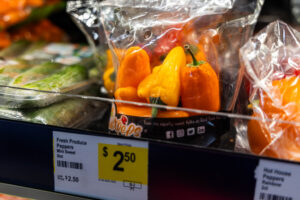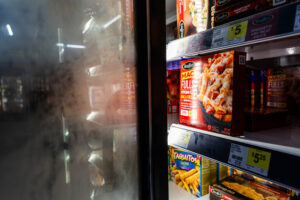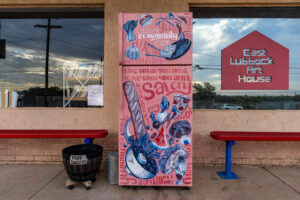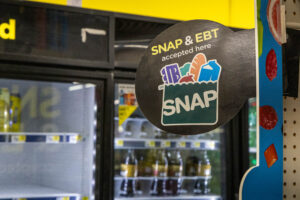
Emma Montgomery

Emma Montgomery
The panhandle of Texas offers miles-long stretches of two-lane roads; corn and cotton fields surrounding either side. Blink-and-you-miss-it towns dot the landscape, often only marked by a flashing four-way stop sign or water tower.
Ransom Canyon, Texas, is bursting at the seams with just over 1,000 residents. Nearly 20 miles away from Lubbock, one of Texas’ larger cities, this community sits lakeside with unique architectural and geological features. What it doesn’t have, however, is reliable access to food and security in nutrition.

Ransom Canyon isn’t the only place lacking food security. The United States Department of Agriculture evaluates food access by measuring accessibility to healthy food sources, individual-level resources that affect accessibility, and neighborhood-level indicators of resources. Any one or a combination of factors, such as distance from a grocery store, having a low income, no vehicle availability, or low access to public transportation results in food deserts. These stressors contributed to leaving 10.2% of U.S. households food insecure in 2021.
Allison Childress, Ph.D., RDN, CSSD, LD, is an Assistant Professor at Texas Tech University, Chief Clinical Dietician at the Nutrition and Metabolic Health Institute and licensed dietician. She said she sees dollar stores as an aid to food insecurity while intensifying nutrition insecurity.
“We are reducing food insecurity but at the same time, there are things that I wish [dollar stores] would do to increase nutrition security,” Childress said. “Let’s start thinking of ways we can increase the nutritional content of the food that [dollar stores] sell.”
Nancy Haynie, a resident of Ransom Canyon, pushes a bright yellow shopping cart through a cluttered Dollar General. Her cart holds milk, bread, microwavable meals, and snacks. She said she frequents this store, coming in three to four times a week.
“What you spend here, you save in gas going all the way into town,” Haynie said, gesturing to her cart.
Haynie said she has a fixed income and the addition of the dollar store to the community holds a significant convenience factor for residents, as well as the low price point. This specific storefront now offers a small produce section, offering peppers, corn, lettuce, grapes and more.
“It’s terrible to have to drive almost 20 miles into town for a tomato,” Haynie said.

However, the Dollar General in Ranson Canyon is the exception, not the rule. There are more than 34,000 dollar stores in the United States, which is more than there are Starbucks, McDonalds, Target and Walmart storefronts combined. While Dollar General has announced intentions to make more stores similar to traditional grocers, with options like fresh produce, meats, cheeses and other goods, this plan would amount to 10,000 of over 30,000 total dollar stores.
“I really like the little store,” Haynie said with a grin and a nod. However, not everyone expresses those sentiments.
Previous studies find that dollar stores, like Dollar General, Family Dollar and Dollar Tree exacerbate food insecurity and food deserts in America. Small food retailers are less likely than supermarkets to sell healthy staple foods, leading to a diet of ultra-processed foods. Some cities have passed policies and ordinances to restrain the number of dollar store expansions to support full-service grocery stores.
There has been exponential growth in these stores in low-income communities, most often affecting marginalized groups. As a result, studies show these communities are significantly less likely to have accessible full-service grocers that offer quality, affordable, healthy options compared to higher-income and majority-white communities.

Childress said eating healthily starts with knowing what is on your plate.
“You want half of your plate to be fruits and vegetables, a fourth of your plate to be grains, preferably whole grains, and a fourth of your plate to be protein,” Childress said. “You want to have healthy oils in moderation.”
When limited to products on dollar store shelves, Childress said to look for canned and frozen fruits and vegetables, dried fruit, cereal with less than 10 grams of added sugar, canned tuna and chicken, and nut butters as healthy options.
“You really have to get creative with how you’re going to design the plates, how you’re going to cook the items, how you’re going to store the items,” Childress said. “Then, you have to be very creative in making sure that you have something from all of those different food groups.”
Childress said education about nutrition is key to finding solutions to nutrition insecurity and can be implemented in dollar stores. Visual guides, signs and nutrition reminders on labels are great ways to connect with a customer, according to Childress.
Experts like Childress are not the only advocates for decreasing nutrition insecurity.
Food bank usage has been on the rise with the assistance of mobile pantry programs, and community gardens expand health, sustainability and economic security. Beyond these tactics, community members like Danielle Demetria East are taking creative approaches to contribute to food equity.

East founded the East Lubbock Art House, a non-profit, community-based arts organization, working toward benefitting the east side of Lubbock, Texas, a historically marginalized community exposed to higher health risks from industrial zoning and lack of food and nutrition security. This program hosts the Lubbock Community Fridges, a place where anyone can put food in or get food out.
“Our community fridge is our hope at helping eliminate food waste and help transient individuals,” East said.
East said the community fridge has received positive feedback, as seen by the continuing donation and pick-up cycle and helping as many as 20 people to regularly get food from the fridge. The steady supply of food provides residents with food security at no cost.
“People feel positively about [the fridges],” East said. “It’s all about meeting the need in the community.”
East encourages people to donate to the East Lubbock Art House and community fridges to grow the program and inspire other programs in other areas. Accessibility to food, especially nutrition food, is revolutionary to residents in food and nutrition deserts.
Creative, community-centric programs and the spread of dollar stores contribute to solving food insecurity, meaning fewer people live their lives with a daunting hunger. Yet, the gap in nutrition insecurity remains. When it comes to solving nutrition insecurity, education and communication are keys.
“Nutrition is a science just like medicine, and the research is changing all the time,” Childress said. “The science is going to change, always. There’s going to be new nutrition recommendations.”

Dollar store retailers have plans to expand their access to healthy options. Federal policy requires retailers that accept EBT and other benefits to have coolers for meal staples, like milk, eggs and meat. Dollar General, specifically, has announced its intention to increase the availability of produce and other traditional grocery store staples.
Access to fulfilling, nutritious food is a human right, but one that is denied to millions of people in America. Enticing dollar stores may not be a complete solution, but they may turn a new leaf into becoming more helpful than harmful. A strong emphasis on the availability of healthy options, education and outreach programs, and reliability to residents could make dollar stores the solution to food and nutrition insecurity in America.